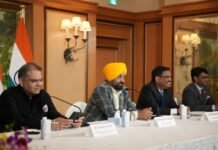A quiet unease is brewing within the ruling Aam Aadmi Party (AAP) in Punjab as fresh reports suggest the emergence of new power centers led by Delhi-based leaders who are increasingly shaping the state’s political course. While the party maintains a strong public posture of unity and reform, internal murmurs of discontent have begun surfacing over what many see as a dilution of Punjab’s political autonomy within the party framework.
At the heart of this brewing tension lies the growing involvement of senior AAP figures from Delhi, notably Manish Sisodia and Satyendra Jain—both of whom, despite facing legal troubles, continue to wield significant influence over strategic decisions. Their perceived backstage control over Punjab’s governance machinery has reportedly sparked friction within sections of the local cadre, who feel overshadowed and increasingly disempowered.
Several party insiders, speaking on condition of anonymity, point to a sense of disappointment among Punjab-based workers who had pinned their hopes on a model of regional empowerment when AAP swept to power in the 2022 assembly elections. The promise of clean governance, decentralised decision-making, and regional leadership had energized voters and volunteers alike. However, the increasing centralisation of authority, especially on matters related to finance, appointments, and major administrative decisions, has reportedly begun eroding that trust.
Adding fuel to the fire is the growing discontent around the AAP government’s much-touted anti-corruption stance. While the party has taken visible actions—such as high-profile arrests and investigations—local functionaries allege that the ground reality has changed very little. In fact, some within the party argue that the ‘corruption rate’ at the local administrative level has only increased, though now allegedly shielded by political patronage rather than exposed by it. This, they say, has created a perception-reality gap that threatens to haunt the party’s image in the run-up to 2026.
From the opposition benches, criticism has been relentless. Leaders from the Shiromani Akali Dal, Congress, and BJP have all accused AAP of double standards—claiming that the very individuals who promised transparency are now promoting centralised control and selective action. Congress leader Partap Singh Bajwa recently stated, “AAP is now showing that it’s no different from the parties it replaced. What’s worse is that decisions for Punjab are being taken in Delhi, not Chandigarh.”
At the organizational level, there are also questions about whether Punjab’s own ministers and bureaucrats are being allowed sufficient latitude. Several recent administrative appointments and departmental reshuffles are believed to have been influenced directly from Delhi, sidelining local recommendations. Even cabinet deliberations, some insiders claim, are now prefaced by pre-approved talking points shared from the central team—reducing what was meant to be collective governance into a tightly choreographed affair.
Despite the internal dissent, Chief Minister Bhagwant Mann has publicly downplayed any rift, insisting that Punjab remains at the center of AAP’s governance model. He has credited Delhi’s leadership for their “experience and guidance,” especially in areas like education reform and fiscal discipline. However, Mann’s frequent visits to Delhi and his close alignment with the national leadership have drawn criticism even from within AAP’s own traditional support base, which includes many grassroots activists from rural Punjab.
Political analysts believe the real test for AAP’s Punjab unit will come not from the opposition, but from within. If the growing perception of Delhi overreach continues, and if allegations of administrative corruption go unchecked, the very foundations of AAP’s regional promise may begin to weaken. For a party that rose to power on the plank of swaraj (self-rule) and people-centric governance, this drift could prove politically costly.
While no open rebellion has yet surfaced, the underlying currents of dissent serve as a reminder: even the most idealistic political experiments are not immune to internal contradictions. Whether AAP can reassert a genuinely decentralized governance model in Punjab—or whether Delhi’s growing shadow will continue to define its fate—remains one of the most crucial questions ahead of the next electoral cycle.
#AAPPunjabCrisis #ManishSisodia #BhagwantMann #SatyendraJain #AAPPowerDynamics #PunjabPolitics #AntiCorruption #DelhiControlDebate #InternalPartyRift #IndianPoliticalNews
This is an auto web-generated news web story.




